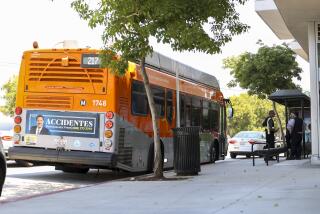City retains faith in transit center
High-speed train service was supposed to be the linchpin of one of Southern California’s largest transit centers. But though proponents envisioned the sleek trains rolling into Anaheim, the governor’s proposed 2007 budget has derailed those plans, at least for now. Yet Anaheim Mayor Curt Pringle isn’t conceding defeat.
“It’s not dead,” Pringle, recently appointed to the California High Speed Rail Authority, said of the long-dreamed-of Anaheim Regional Transportation Intermodal Center between Angel Stadium and the Honda Center, from which, proponents say, passengers could someday be whisked to Los Angeles in 20 minutes.
The mayor has his skeptics, given the June 30 deadline for legislators to reverse Gov. Schwarzenegger’s request to slash the project’s funding from the budget and postpone indefinitely a $9.95-billion rail bond expected next year.
“Our responsibility,” Pringle said, “is to convince the Legislature to continue putting money into study and preliminary work and to convince the public that this is still a good way to spend money.”
For nearly a decade, Orange County transportation planners have moved forward with the plan for Anaheim’s station of the future. To accommodate it, the Orange County Transportation Authority bought 13 acres of prime real estate the county owned near Angel Stadium for $32.5 million. And in September, at the prodding of Pringle and other board members, the agency approved spending $7 million to determine whether the Los Angeles-to-Anaheim rail corridor could handle trains traveling up to 200 mph.
Plans call for the transportation center to include the county’s largest bus terminal, a parking structure, platforms for Amtrak and Metrolink trains, and room to add tracks for high-speed rail. But critics say that without rail the new facility would be just another bus station.
Other critics question spending money on high-speed rail at all. Californians who love their automobiles, they argue, will be reluctant to park them and board trains. And though gas prices are high, they say, they’re still much lower than in Europe where high-speed trains have been successful.
“The problem with the governor’s proposed budget on high-speed rail is that [the slashes] didn’t go far enough,” said James E. Moore, director of the transportation engineering program at USC. With hundreds of miles of precision guideways, right-of-way costs and tunnels, he said, “you would simply never recover the money it takes to build.”
OCTA bus drivers, locked in a contract dispute, would like to use the $7 million earmarked for the study to increase wages and benefits, said Patrick D. Kelly, secretary-treasurer for Teamsters Local 952. “I would love to hop a train and go from here to San Francisco,” he said. “That would be a kick. But it sounds like too much pie in the sky.”
But Art Leahy, OCTA’s chief executive, argues that adding Metrolink trains is a necessary step for the future. “It used to be that Orange County had the workers and L.A. had the jobs,” he said. “But L.A. is emerging as Orange County’s biggest suburb.”
The first phase of Anaheim’s proposed station construction is scheduled for completion by 2012, transit officials said. It calls for moving the existing Amtrak-Metrolink station now in the parking lot of Angel Stadium, building a parking structure and constructing bus amenities.
Ridership estimates are under review, Pringle said. And a number of financial options are being studied.
“I believe [high-speed rail] is still on its path and moving forward,” the mayor said.
More to Read
Sign up for Essential California
The most important California stories and recommendations in your inbox every morning.
You may occasionally receive promotional content from the Los Angeles Times.










